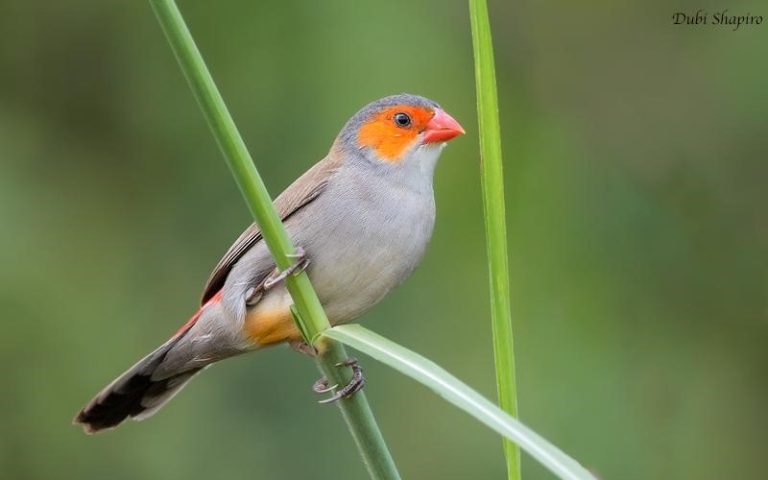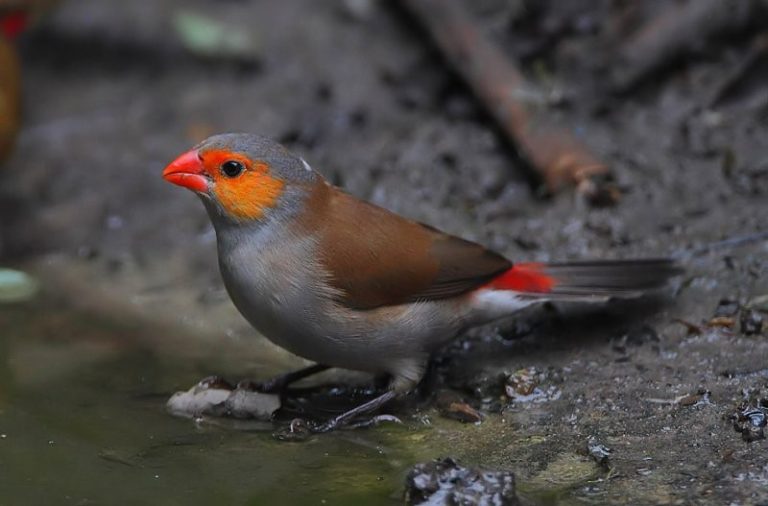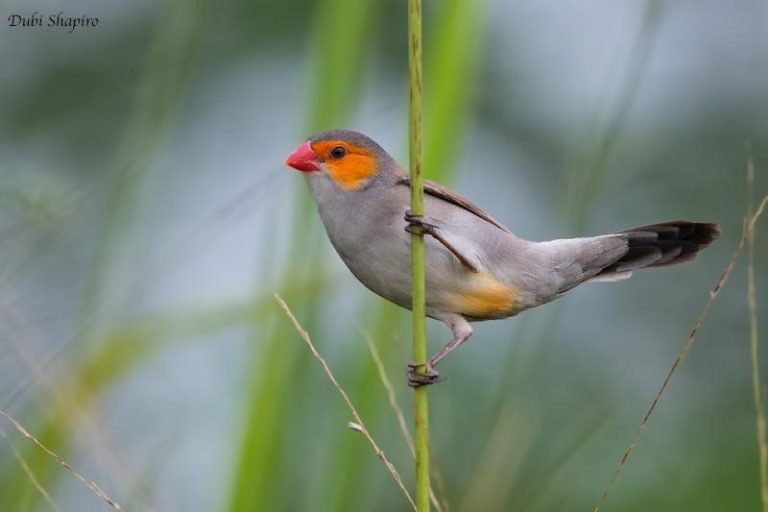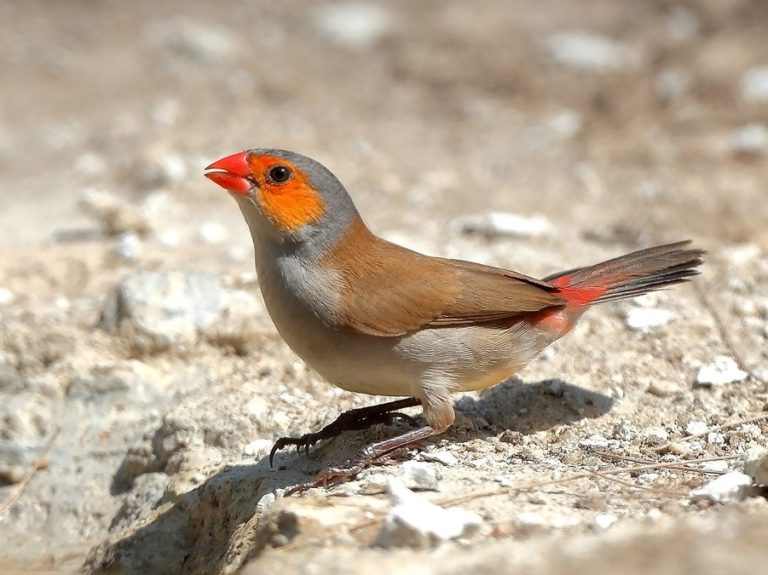Birdfinding.info ⇒ Common in many parts of its natural range, including Senegal, Gambia, Ghana, and the coastal lowlands of Cameroon and Gabon. On Puerto Rico it is common throughout the coastal lowlands and in several interior valleys—it can usually be found at Laguna Cartagena, Boquerón, Punta Guaniquilla, and Hacienda La Esperanza. In California, the best site is Huntington Beach Park in Orange County. On Maui, it is found mainly in the central depression, especially at Kealia Pond and Waihee. In Singapore, it is seen most consistently at Bishan-Ang Mo Kio Park.
Orange-cheeked Waxbill
Estrilda melpoda
Tropical western and central Africa; widely introduced elsewhere.
Inhabits humid grasslands and grassy brush and woodlands of tropical western Africa from Senegal and the southern edge of Mauritania east to southwestern Chad, the Central African Republic, westernmost Uganda, Rwanda, and Burundi, and south to northern Angola and northernmost Zambia.
Introduced populations are well-established on Puerto Rico and Taiwan. The Puerto Rican population was introduced from Africa via vessels of the slave trade, and has been part of the island’s avifauna since the early or mid-1800s.
Smaller introduced populations are more tenuously established in: southern Spain (mainly in the Río Mijares estuary area, north of Valencia); Singapore; the Mariana Islands (Saipan and Tinia); Hawaii (mainly Maui; formerly also Oahu); southern California; southeastern Texas (Houston area); Guadeloupe; and Martinique. A small population existed on Bermuda in the 1990s, but has since disappeared.
Identification
Unique: a small, slender finch with bright orange cheeks and lores, and a rosy bill. Otherwise mostly gray with a brown back and wings, white vent, and red rump.

Orange-cheeked Waxbill. (Winneba Plains, Ghana; August 12, 2016.) © Dubi Shapiro

Orange-cheeked Waxbill. (Kehei, Maui, Hawaii; September 10, 2017.) © Sharif Uddin

Orange-cheeked Waxbill. (Maui Lu Resort, Maui, Hawaii; July 23, 2013.) © Jerry Ting

Orange-cheeked Waxbill. (Barrio Naranjo Comerío, Puerto Rico; December 1, 2013.) © Ernesto Burgos

Orange-cheeked Waxbill. (Abuko, Gambia; December 7, 2009.) © RAINBIRDER

Orange-cheeked Waxbill. (Kealia Pond National Wildlife Refuge, Maui, Hawaii; September 12, 2005.) © Michael Walther

Orange-cheeked Waxbill. (Lorong Halus, Singapore; June 30, 2012.) © Andy LYT

Orange-cheeked Waxbill. (Winneba Plains, Ghana; August 12, 2016.) © Dubi Shapiro

Orange-cheeked Waxbill. (Punggol Barat, Singapore; August 20, 2019.) © Sheau Torng Lim

Orange-cheeked Waxbill, immatures. (Waihe’e Refuge, Maui, Hawaii; May 5, 2018.) © Alan Schmierer
Immature plumage is a muted, brown-and-beige version of the adult’s. The bill is black, as in other immature waxbills.

Orange-cheeked Waxbill, immature. (Cabo Rojo, Puerto Rico; November 28, 2017.) © Michael Willison

Orange-cheeked Waxbill, immature. (Barrio Naranjo Comerío, Puerto Rico; December 1, 2013.) © Ernesto Burgos
Notes
Monotypic species.
References
BirdLife International. 2018. Estrilda melpoda. The IUCN Red List of Threatened Species 2018: e.T22719558A131994459. https://dx.doi.org/10.2305/IUCN.UK.2018-2.RLTS.T22719558A131994459.en. (Accessed April 1, 2020.)
Brazil, M. 2009. Birds of East Asia. Princeton University Press, Princeton, N.J.
eBird. 2020. eBird: An online database of bird distribution and abundance. Cornell Lab of Ornithology, Ithaca, N.Y. http://www.ebird.org. (Accessed April 1, 2020.)
Payne, R. 2020. Orange-cheeked Waxbill (Estrilda melpoda). In: del Hoyo, J., Elliott, A., Sargatal, J., Christie, D.A. & de Juana, E. (eds.). Handbook of the Birds of the World Alive. Lynx Edicions, Barcelona. https://www.hbw.com/node/61110. (Accessed April 1, 2020.)
Pyle, R.L., and P. Pyle. 2017. The Birds of the Hawaiian Islands: Occurrence, History, Distribution, and Status. Version 2 (January 1, 2017). http://hbs.bishopmuseum.org/birds/rlp-monograph/. B.P. Bishop Museum, Honolulu, Hawaii.
Raffaele, H., J. Wiley, O. Garrido, A. Keith, and J. Raffaele. 1998. A Guide to the Birds of the West Indies. Princeton University Press, Princeton, N.J.
van Perlo, B. 2002. Birds of Western and Central Africa. Princeton University Press, Princeton, N.J.
Xeno-Canto. 2020. Orange-cheeked Waxbill – Estrilda melpoda. https://www.xeno-canto.org/species/Estrilda-melpoda. (Accessed April 1, 2020.)

